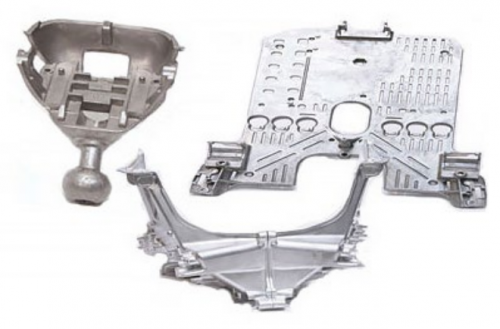Latest Resource Explores Advancements in Die Casting
Leave a CommentSince the Great Recession in 2008, applications for high-pressure die casting (HPDC) have experienced a major surge. HPDC is one of the most widely used metal forming processes thanks largely to its versatility, accuracy and repeatability. The automotive industry alone accounts for over half of the die casting industry’s current output.
HPDC in the Automotive Industry
There are several reasons HPDC is a popular method within the automotive industry. For starters, automotive designers quickly realized the potential in HPDC based on its ability to successfully achieve crash and safety-critical application requirements. HPDC also helps the growing interest in overall improved consumption by reducing weight of vehicles.
Other benefits of HPDC in automotive applications include dimensional repeatability, cost-efficiency and superior finish.
Growing List of Alloys
 Major alloys that account for most of the die castings produced in North America today are aluminum, magnesium, zinc and zinc aluminum. Alloys specifically designed for use in die casting have evolved greatly over time. The original three materials used in die casting were lead, tin and zinc, each of which are still used today. These materials have low melting points and high malleability, while aluminum and magnesium are lighter than steel and have high strengths and strength-to-weight ratios.
Major alloys that account for most of the die castings produced in North America today are aluminum, magnesium, zinc and zinc aluminum. Alloys specifically designed for use in die casting have evolved greatly over time. The original three materials used in die casting were lead, tin and zinc, each of which are still used today. These materials have low melting points and high malleability, while aluminum and magnesium are lighter than steel and have high strengths and strength-to-weight ratios.
One material that has recently been added to die casting alloys is strontium. This highly reactive metallic element protects against die soldering, allows for reduction in iron levels and strengthens die cast aluminum. Another newer alloy suited to HPDC automotive application is A380, which features more elongation than other alloys. It is a low iron, high copper alloy to which strontium can be added, and it possesses good tensile, yield, impact and sheer strengths.
Newer forms of die casting technologies and variant procedures include squeeze casting, semi-solid metal casting and vacuum die casting, all of which are implemented to manufacture a near infinite array of parts for many different industries.
About NADCA
The North American Die Casting Design Association is proud to have funded research and development that have led to the discovery of aluminum alloy A380. NADCA is committed to providing useful resources related to product specification standards for die casting along with many other educational materials to aid in the designing of an optimized die cast product.
Download our eBook, Die Casting Advancements, for more information on the latest technological advancements of die cast products.




